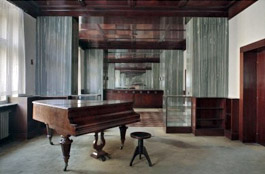
Prague wants to make accessible the interiors created by Adolf Loos
 |
Some of Loos's apartments are owned by private individuals, while the city owns four of them. Although the interiors are not complete, they represent a Europeanly valuable example of the architect's work. The city also plans to start negotiations with the region this year about the possible establishment of a Center for Research on 19th and 20th Century Architecture, including a permanent Loos exhibition.
Loos often stayed in Plzeň, and his last wife, photographer Claire Beck, came from there. He renovated, for example, the Brummel House on Husova Street and created 13 apartment interiors. Experts consider them to be extremely valuable. Not all of them have been preserved.
The city owns, for example, the apartment at Klatovská 12. The original living room and dining room are currently used by the city's Public Property Administration as meeting rooms. At Klatovská 19, in a building previously managed by the military, four original rooms have been preserved - a music salon, salon, dining room, and a fragment of a children's room. On Bendova Street, there is a living room connected to a dining room and a bedroom.
At Klatovská 110, the original owners' apartment has been divided into four residential units and a studio. The principle of the so-called Raumplan, a spatial plan that offered a living hall and gallery with entrances to individual rooms on the first floor, has been preserved in the building. A permanent Loos exhibition and a center for 19th and 20th-century architecture could be established in this building.
The future of Loos's interiors in Plzeň is part of the cultural development program for the period from 2009 to 2019. Plans include the creation of a guided tour route focusing on modern Plzeň architecture. In addition to Loos's work, it would present the development of bourgeois architecture from historicism to functionalism. This year, the city should complete an artistic crafts passport and a historical architectural survey of the apartment at Klatovská 110. These are materials necessary for the reconstruction. The interiors will require repairs in the coming years; a complete renovation of the building at Klatovská 19 is planned. According to earlier city plans, the Patton Memorial Museum is also expected to move into it.
Loos (1870 to 1933) is considered the most significant Central European architect of the early 20th century and a co-founder of modern purist architecture worldwide. His style is characterized by clean rectangular shapes, absence of ornaments, simple functional form, and noble materials.
The English translation is powered by AI tool. Switch to Czech to view the original text source.
0 comments
add comment
Related articles
0
12.04.2019 | In the Plzeň house with Loos interiors, there will be a new Patton Museum
0
09.09.2018 | Plzeň has a study for the renovation and utilization of the house with Loos' interiors
0
30.11.2015 | There is interest in the apartment tours from Loose in Plzeň, with 10,000 people having seen them
0
12.11.2015 | Another Loos interior in Pilsen opened to the public
0
28.03.2015 | Repair of the unique Plzeň house by Loose took 12 years
0
25.03.2015 | Plzeň will offer regular tours of Loos' interiors
0
09.03.2015 | Loos interiors in Plzeň may be on the European Heritage List
0
06.03.2015 | Plzeň is willing to pay the contractual penalty for the house with Loose interiors
0
18.12.2014 | The house with interiors by Loose will be gradually renovated by the gallery in Plzeň
0
12.12.2014 | Plzeň will not return the house with the valuable interior by Loose to the state for now
0
28.10.2014 | People in Pilsen have seen another interior by the world-renowned A. Loos for the first time
0
13.10.2014 | The route through Loos's interiors in Plzeň will offer several sites
0
23.05.2014 | Plzeň is preparing a tour route through the interiors by Adolf Loos
0
12.08.2013 | Plzeň is reconstructing the valuable Loos apartment, will offer a cultural space
0
19.03.2013 | Plzeň will open Loos's interiors for one day
0
05.04.2012 | Plzeň is preparing a reconstruction of an apartment with an interior designed by architect Loose
0
29.02.2012 | Plzeňský region will support projects of the capital city of culture
0
11.10.2011 | Exhibition in Pilsen presents the extensive work of architect Adolf Loos
0
17.04.2011 | The preservationist discovered a unique interior by Adolf Loos
0
06.04.2011 | Plzeň will make unique interiors by Loose accessible for one day
0
08.09.2010 | Plzeň will exceptionally make the valuable interiors of Adolf Loos accessible
0
05.09.2008 | In Pilsen, an apartment by Adolf Loos will be occasionally open to the public










